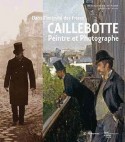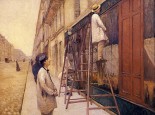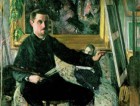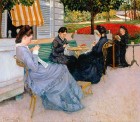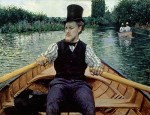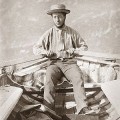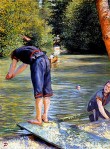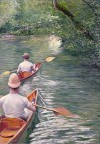The browser will either open the file, download it, or display a dialog.
Dans l'intimité des frères Caillebotte, peintre et photographe
March 25 – July 11, 2011
Musée Jacquemart-André, Paris
October 7 – 8 January 2012
Musée National des Beaux-Arts de Québec, Québec
Catalogue :
De l’intimité des frères Caillebotte. Peintre et photographe
With contributions by Serge Lemoine, Anne de Mondenard, Eric Darragon and Julien Faure-Cornoton.
Paris : Skira Flammarion, 2011.
240 pages; illustrations in color and b/w; essays, catalogue entries, bibliography.
39€ [published in French]
ISBN: 2081257068
Long considered as Impressionism’s stylistic outsider, the late nineteenth-century painter Gustave Caillebotte favored seemingly retrograde narrative structures and crisp facture, techniques more closely related to the visual rhetoric of realism and even traditions of academic art rather than the optical light effects and bright colors that are taken to be the trademarks of Impressionism. Born to a wealthy family, Caillebotte was not obliged to earn a living with his art and instead acted as a patron to other less financially advantaged Impressionist artists. After his death in 1894, Caillebotte donated his important collection of paintings by his friends, including Claude Monet, Pierre-Auguste Renoir, Edgar Degas and Camille Pissarro to the French state, which famously rejected one-third of it. The Caillebotte bequest now forms an important part of the Musée d’Orsay’s collection of Impressionist paintings, including Renoir’s Moulin de la Galette and Edouard Manet’s Balcony. While the artists whose works he collected have become the subjects of countless exhibitions and monographs over the course of the twentieth century, until recently Caillebotte had received comparatively little attention, a trend that has now reversed itself thanks to pioneering scholarship over the last thirty years.
A recent exhibition at the Musée National de Beaux-Arts du Québec and the Musée de Jacquemart-André in Paris provided visitors with the opportunity to view fifty paintings by Gustave Caillebotte that have remained in the private collection of his descendents, along with over 150 photographs taken by his younger brother, Martial Caillebotte, that have also remained in the family’s private collection.[1] Organized into five different thematic sections, each room presented Gustave’s paintings and Martial’s photographs on separate walls, a curatorial decision that emphasized the material differences between their respective oeuvres while also positing a certain degree of similitude in terms of their subjects. While visitors to the exhibition benefited from a rare and valuable opportunity to encounter works of art that are normally not on public view, the lessons to be learned from the exercise of comparing Martial’s photographs to Gustave’s paintings remain ambiguous. The introductory text panel displayed before visitors entered the galleries presented the exhibition’s overall objective: to “reveal the profound affinities that are both personal and artistic” between Gustave’s paintings and Martial’s photographs. The panel describes how both brothers had a love for yachting, stamp collecting, gardens, and “simple pleasures,” a list of interests that a good number of nineteenth-century men of leisure no doubt also shared. Beyond these hobbies, it is the exhibition’s title, Dans l’intimité des frères Caillebotte, that best reveals the logic behind the display of these two very different oeuvres, namely that of the familial bond between the two brothers. This raises an important question as to whether or not the biological relationship between two brothers is a strong enough conceptual underpinning to engage critically with late nineteenth-century visual production across a range of media.
The dual focus on painting and photography creates the expectation of a connection that extends beyond the fact that both brothers photographed and painted many of the same things, a point that was repeatedly affirmed by the text panels in the gallery. Visitors also could be forgiven for thinking that this might be an occasion for making a new contribution to the vibrant art historical debate surrounding the relationship between late nineteenth-century painting and photography, the historiography of which is succinctly outlined in Anne de Mondenard’s informative catalogue essay, “Visions des peintres, regards des photographes: histories croisées.” While the exhibition avoids the conceptual trap of reducing this complex relationship into a one-way street of formal influence where photography is understood to transform the spatial logic of painting, the arrangement of the works in the gallery, and the accompanying didactic information, neglect to define what that relationship might consist of beyond a superficial notion of shared subject matter. Since the vast majority of Martial’s photographs were produced in the years after Gustave’s untimely death in 1894 at the age of 45, it is plausible that the photographer looked to the painter for formal inspiration. This is a possibility discussed in the catalogue essays by Anne de Mondenard and Julien Faure-Cornoton, “La mémoire des jours: l’oeuvre photographique de Martial Caillebotte,” although both authors caution against openly embracing a direct formal correspondence as the driving force behind Martial’s practice. They instead contextualize his photographs within the milieu of late nineteenth-century amateur photography. In this sense, the catalogue performs a valuable service of defining the relationship between Gustave’s paintings and Martial’s photographs in a way that the gallery installation does not. The handsome exhibition catalogue, with well-written and informative essays, dozens of color plates and individual notices for every painting and several thematic groups of the photographs, contributes to the value of the show (fig. 1).
While there can be no doubt that Martial’s photographs are worthy of careful art historical scrutiny in the context of larger considerations of fin-de-siècle amateur photography, on a purely visual level they appear out of place next to the fifty paintings made by his brother. The impression that the photographs are playing second fiddle to the paintings is confirmed by different strategies of display applied to both bodies of work. Each of the paintings merited individual wall text panels that provided the title and date. For a select number of important works, salient contextual information also was included. In contrast, the much smaller photographs were displayed four to a frame and were treated not as individual images, but as thematic groupings and given descriptive titles such as “Monuments de Paris” and “Les petits métiers de Paris,” to name just two. Apart from this thematic context, no further information was given, neither date nor title. To make matters worse, all of the photographs on display were contemporary reprints of the nineteenth-century originals. This decision was explained in the wall text that introduced Martial’s photographs: “The extreme fragility of the original supports (photographic albums, soft supports or glass plates)…required that contemporary prints as close to the originals as possible be presented.” Though it is commendable that the owners of the collection of photographs wanted to preserve and protect the family archive, one wonders why an agreement could not have been reached to display a token few of these original albums or glass plates in a temperature-controlled case, or at the very least, photographs of what the original supports look like. The choice to exhibit the contemporary reprints bereft of contextual information and any indication of their original material specificity exacerbated the division between the two bodies of work and provoked further questions as to what is to be gained by exhibiting them together.
The first thematic section of the exhibition, “Paris en Perspectives,” is arguably the most dazzling in terms of the paintings on display. In one small room, three walls are devoted to Gustave’s painterly investigations of a radically transformed post-Haussmann Paris. The room is dominated by one of his early large-scale works, The Building Painters from 1877 (fig. 2). The painting provocatively stages an encounter between the artist’s labor as a bourgeois artist and that of the urban worker-painters who are pictured. The other two walls also feature paintings of Paris that employ similarly plunging perspectives, a stylistic hallmark of Gustave Caillebotte’s unique brand of modern painting. This room also does an excellent job of introducing viewers to Caillebotte’s negotiation of the delicate balance between human figures and the spaces they occupy, a theme that carries through the entire exhibition. A small oil sketch for Paris, Rainy Day Street Scene, entitled Man and Woman under an Umbrella, addresses the issue of spatial balance between human figures and the urban landscape. Here, the painter disposes entirely with the landscape and focuses entirely on the figures that stand out against a Manet-like grey and vacant background. Other paintings include the 1880 Boulevard Seen from Above and Refuge, Boulevard Haussmann, where newly installed traffic circles and iron grating served as the impetus for experimentation with scale and a striking, downcast point of view.
In contrast to the precise drawing and clean facture of his large-scale works such as The Building Painters, some of the smaller scale paintings on display in this first room, and throughout the exhibition, show a different side of Caillebotte. The four balcony paintings on display, including Man on a Balcony and Boulevard Haussmann, Snow Effect, are sketchy with expressive, open brushwork that is more in keeping with the stylistic proclivities of Caillebotte’s contemporaries Renoir and Monet, minus the expansive palette. Nowhere is this more materially striking than the thick impasto of Boulevard Haussmann, Snow Effect, where the accumulated snow on the balcony railing is expressed through built up white, grey and brown paint. In the face of such striking demonstrations of the physical effects of paint on a canvas, the photographs on one side of the same room struggle to make an impact. Martial’s photographs of Paris monuments, including the Garnier Opéra and the Trocadéro, are displayed in a small frame next to his photographs of the newly refashioned Opera neighborhood of Paris, in which the two brothers lived. One photograph in particular that the catalogue has listed as Traffic-circle, View from the Balcony of 9, Rue Scribe, but was without title in the gallery, demonstrates a plunging point of view strikingly similar to that in some of Gustave’s paintings (72). It is here that one can understand just how Martial’s practice was indebted to his brother’s pioneering representations of the same motifs.
The exhibition continues with the next two galleries devoted to the theme of “The Intimacy of the Caillebotte Brothers,” from which the exhibition derives its name. From this second room onward, the small gallery spaces promoted this concept in an altogether different way than the works on display, with crowds of people crammed inside of the small rooms. In the hot days of June and July, the temperature and humidity levels also reached shocking heights. Air conditioning units were then brought in to alleviate the adverse conditions, which they did only partially. As in the previous section, Gustave’s paintings dominated the space and were displayed on three of the walls in each of the two rooms devoted to the theme of the Caillebotte family’s private interior spaces. In both the paintings and the photographs, the bourgeois habits of the Caillebotte family are defined in relationship to the world of material objects with which they interact. For example, Gustave’s unfinished Self-Portrait at the Easel posits the artist’s status as a maker of paintings and as an enthusiastic collector of them, with Renoir’s Moulin de la Galette in the background (fig. 3). The portraits of Eugène Daufresne Reading and of Madame Martial Caillebotte, both dressed in black and immersed in solitary activities, picture the sitters in front of the same mantel and golden statue. But it is in the standout painting of the Luncheon, shown at the Impressionist exhibition of 1876, where the suffocating gentility of bourgeois culture becomes most palpable. In this extraordinary image with its vertically tilted perspective and dramatic cropping of the various objects on the table, Caillebotte’s younger brother and mother dine, but not as a cohesive family unit. As the informative catalogue entry points out, the younger brother has started eating before his mother, who is still taking food from a tray held by a servant (102). The appearance of awkward sociability stems from the importance that Gustave accords to the world of objects that come to structure familial relations. The two family members sit at the same table, although they are separated by a gulf of decanters, vases, glasses and plate settings.
Many of Martial’s photographs hanging on the opposite side of the room depict similar interiors filled with the material trappings of bourgeois wealth, but devoid of the weighted atmosphere found in Gustave’s paintings. This is largely due to Martial’s habit of framing his human subjects in the center of the room and his use of the flash. As in his brother’s paintings, Martial’s figures are often represented as engaged in solitary activities. We look at them playing the piano, taking a bath and reading, but we also maintain a distance from this activity as viewers, since they have the appearance of being posed by the photographer. Here, Gustave’s paintings provide an interesting point of contrast. The people depicted in the wonderful trio of Interior, Woman Reading, Interior, Woman at the Window, and The Piano Lesson, are all immersed in activities. But instead of beholding their activity from a detached distance, the compressed spaces of the paintings promote the illusion that we are sneaking a peak into private moment.
The exhibition continues with the next section, “The Pleasures of the Garden,” which focuses on the Caillebotte family’s country homes outside of Paris and the passion for gardening shared by both brothers. Somewhat uneven in terms of the quality of the paintings and extremely cramped as a gallery space, this part of the exhibition nevertheless shows the impressive stylistic range that Gustave had as a painter. Both Vegetable Garden, Yerres and Garden Path of Petit Gennevilliers feature open brushwork that could be taken for paintings by his friend Monet, and a preoccupation with unique light effects generated in the lush planted landscape. These paintings stand in stark contrast to the more resolved facture of Portraits in the Country, in which Gustave returns to the theme of solitary domestic activities from the previous section (fig. 4). Though the female members of the family have been transported to the countryside, they still engage in the same sorts of activities that they did in the city. This section also contains several still lifes including the radically cropped Orchids, in which a basket of these exotic plants stretch down from the roof of a greenhouse whose iron structure is depicted through bold strokes of heavy grey paint. These same greenhouse orchids served as the subject for four large decorative panels that were painted for the dining room of the Caillebotte’s home at Petit Gennevilliers. In the gallery, these doors were displayed on fake moldings to recall their original function. While this constituted a worthy attempt to contextualize these objects, an informative wall text panel would have been much more illuminating. On the far wall in the gallery, Martial’s photographs depicted scenes of family leisure—children at play and family outings—as well as Gustave tending to his greenhouse, probably the same one painted in the large decorative panels.
After tracking back through the domestic interior section, one encounters the fourth part of the exhibition, “The Modern Landscape,” which could easily have been the name of the first section that featured representations of a post-Haussmann Paris. For the purposes of thematic grouping, the “modern” here is defined by the presence of heavy industry: railroads, bridges and factories. By far the smallest and most cramped space in the exhibition, nonetheless the four paintings are some of the most interesting. Two studies for Gustave’s ambitious 1877 painting, Pont de l’Europe, hang together; one features the Haussmann-era bridge near the Gare St. Lazare on its own and the other includes figures in front of it more closely resembling the final large-scale painting. This hanging sheds further light on Gustave’s practice of locating a delicate balance between figures and the modern spaces they inhabit. The large unfinished painting of Landscape of Railroad Tracks focuses on the industrialized landscape outside of Paris, in an unspecified location. As in the studies for the Pont de l’Europe, plunging perspectives and dramatic cropping permit the space to play a subtle game with viewers, who strive to make it behave optically. Here, train tracks cut a curving vertical line from the background into the foreground, which is interrupted by a recalcitrant horizontal railing that hovers above the ground below. The painting’s spatial complexity hinges upon a simultaneous gaze down at the tracks and back toward the horizon. Here, Gustave’s radical composition helps to accentuate the modernity of the railroad tracks, rendering them all the more strange and novel. Martial’s photographs repeat the same motifs, including railroad tracks, but in the company of his brother’s remarkably original spatial investigations of the features of modern life, they are not nearly as interesting to behold.
The last section of the exhibition focuses on one of Gustave and Martial’s shared passions, boating. In contrast to the previous room with only four paintings, there are nearly a dozen here; the photographs and the paintings are more closely aligned in terms of their subject matter and some occasionally striking formal overlaps. The first room in this last part of the exhibit brings together a series of paintings and photographs depicting sailboats. Gustave’s paintings such as Sailboat on the Seine at Argenteuil and Sailboat on the Seine represent the water around the boats through several different shades of thickly applied blue paint. But when it comes to the sails, a different mode of paint handling takes over and they appear instead as thick white blocks of color. Martial’s photographs similarly render the sails as opaque white triangles. Here, it is tempting to speculate whether or not Gustave may have worked from some of his brother’s photographs of sails, since these sailboat paintings were made in 1893, the year that Martial began to take photographs. While this remains pure conjecture, this section’s hanging more convincingly demonstrates how Martial looked to Gustave’s paintings for formal inspiration. In the second room of this last section, Martial’s photograph of Maurice Minoret Rowing appears to be a restaging of Gustave’s painting of the Boater in a Top Hat, exhibited at the fourth Impressionist exhibition of 1879 (figs. 5 and 6). While this is a conclusion that most viewers probably reached on their own, the complete lack of didactic information limited the depth of inquiry about the nature of the relationship between the painting and the photograph. Despite this absence, this last room of the exhibit benefits from the display of Gustave’s ambitious triptych of large-scale decorative panels of pastoral waterside scenes painted at Yerres, also exhibited at the fourth Impressionist exhibition of 1879. The panels depict scenes of boating, bathing, and fishing and have rarely been on public view as a unified ensemble. They feature divided brushstrokes, a focus on outdoor light, and rely on a palette of rich blues and greens that is reminiscent of the paintings of Renoir and Monet (figs. 7 and 8). As such, they differ sharply from his most well-known paintings like Paris Street, Rainy Day, Pont de l’Europe, and Floor Scrapers with their muted tones, crisp facture and arresting psychological complexity.
While it is for the most part unclear how the photographs add to our understanding of Gustave’s paintings and vice versa, the opportunity to view a large selection of paintings normally kept in a private collection more than compensated for the exhibition’s perplexing conceit of illuminating the similitude between the brothers’ paintings and photographs. In the end, it is difficult to understand what viewers are supposed to take away from the comparison, other than the fact that Gustave Caillebotte had a brother who happened to take photographs, some of which were inspired by his paintings. One hopes that the family will one day agree to lend the original albums to an exhibition, where they can be examined in the context of other amateur practitioners of photography and not have to participate in an unwinnable sibling rivalry.
Katie Hornstein
khornstein[at]gmail.com
[1] The reviewer visited the exhibition at the Musée de Jacquemart-André in Paris.


